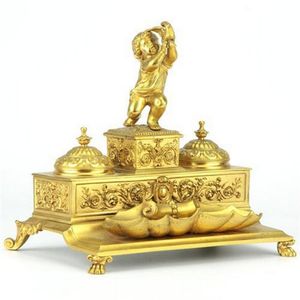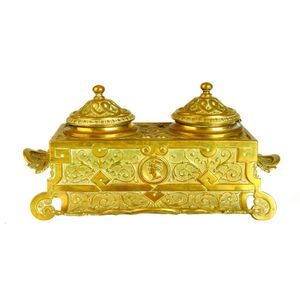Gilded Brass Inkwell Desk Set with Cupid and Dove
You must be a subscriber, and be logged in to view price and dealer details.
Subscribe Now to view actual auction price for this item
When you subscribe, you have the option of setting the currency in which to display prices to $Au, $US, $NZ or Stg.
- Cupid Motif - The Cupid motif, which features the Roman god of love and desire, Cupid, was a popular decorative element in classical ornamentation. Cupid was often depicted as a winged, naked baby with a bow and arrow, and was often used to symbolize love and desire.
In classical art and architecture, Cupid motifs were often used as decorative elements on furniture, such as on the legs of chairs and tables, as well as on architectural elements such as friezes and pediments. They were also used as decorative elements in frescoes, mosaics, and other forms of art.
During the Renaissance, Cupid motifs were often incorporated into the decoration of palaces, churches and other grand buildings, as they were seen as symbols of love and fertility. Cupid motifs were also commonly used in the decorative arts of the Baroque period, often appearing in the form of putti, which are small winged cherub figures.
In addition to their decorative use, Cupid motifs were also believed to hold symbolic meaning, as they were thought to evoke feelings of love, desire, and fertility. - Gilding - Gilding is a method of ornamentation whereby a thin sheet of gold metal is applied to items made of wood, leather, ceramics, glass and silver for decorative purposes.
For furniture including mirrors, the sheet of gold is usually applied over a coating of gesso. Gesso is a mixture of plaster of Paris and gypsum mixed with water and then applied to the carved wooden frames of mirrors and picture frames as a base for applying the gold leaf. After numerous coats of gesso have been applied, allowed to dry and then sanded a coat of "bole", a usually red coloured mixture of clay and glue is brushed on and allowed to dry, after which the gold leaf is applied. Over time parts of the gilding will rub off so the base colour can be seen. In water gilding, this was generally a blue colour, while in oil gilding, the under layer was often yellow. In Victorian times, gilders frequently used red as a pigment beneath the gold leaf.
Metal was often gilded by a process known as fire gilding. Gold mixed with mercury was applied and heated, causing the mercury to evaporate, the long-term effect of which was to kill or disable the craftsman or woman from mercury poisoning. The pursuit of beauty has claimed many victims, not the least of which were the artists who made those pieces so highly sought after today.
This item has been included into following indexes:
Visually similar items

French bronze gilt ink stand with an applied figure of a cherub with a dove on a square form plinth, flanked by two lift top compartments above a scroll form pen rest, all standing on two scroll & two claw feet. condition good, minor age related wear. Leng

An impressive neoclassical silver ink stand, mark of Frederick Elkington, Birmingham, 1888, shaped oblong with central well surmounted by finial cast as putto reading, above egg and dart bordered recesses flanked by cut crystal inkwells with metamorphic li

A rare historical brass inkstand belonging to Capt. Robert Falcon Scott 'And was with him at the South Pole', 19th century cast brass with twin hinged lidded pots, decoratively cast with various scrolling designs, the rectangular body with wide curved side

A Tibetan gilt-bronze figure of Buddha Shakyamuni, 15th century, seated in 'bhumi-sparsha'(earth-touching mudra) on a high double -lotus throne, a scroll inside the base, unsealed, Kasamala Kingdom, Western Tibet, 17.4 cm high
